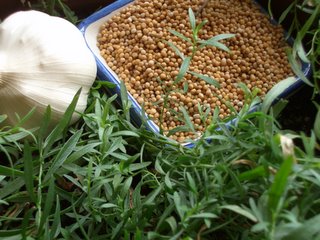Tarragon and garlic mustard

Mustards are easy to make. You can buy many striking ones when you’re on holidays in country towns, cute jars with gingham cloth covers and handwritten labels … rhubarb, quince and chocko mustard … or whatever. Inventive combos, and they may sit in the cupboard and desiccate for a few years before you chuck them. I’ve come to like purpose-built mustard. I know what I like it with (croque monsieur/madame, welsh rabbit, roast beef, steaks, grilled veal) and in (creamy chicken pie fillings, deglazed sauces, salad dressings), so I know what flavour I want from my little jar.
This one suits so many dishes and situations. I love tarragon – the anise sharpness that raises vinegar to peppery heights. Warm caressing garlic to round out the sharpness. And no ordinary tarragon or tarragon vinegar, mind. I have a tarragon plant (she says smugly) – one of the treasures of my balcony's mini herb patch. You can rarely buy tarragon plants in shops, green grocers, supermarkets, plant nurseries, or shady underworld dealers. Proper French tarragon, not that saw-tooth leaved weed they pass off by calling it something like ‘Russian’ tarragon. May as well be from outer space. Don’t bother, it tastes like sour grass clippings.
Real tarragon is hard to find because it’s hard to grow and nurture. It doesn’t seed (so no progeny, no passing on to happy seed savers) hates the unprotected bitter cold, hates being dried out, but loves the sun. Gets miffed if you ignore it, has a hissy fit if it’s left in a wet spot, but if you love it and treat it right, it will become abundant and happy and keep you in a lifetime of rich béarnaise, Spanish chicken, salad garnishes, egg dishes and flavoured vinegar. It has an affinity for good wine sauces. Sounds a bit like me really.
If you have a really good friend who has a tarragon plant, ask them to give you a divided offshoot when it goes dormant in late Autumn, then wait til Spring for it to sprout. My family and I divide and share around our tarragon plants and have done for about 10 years. It’s the only way we can be sure of the real thing.
Soak 100 grams of yellow mustard seeds in ½ a cup of tarragon vinegar overnight. Pour this into a food processor, liquidiser or long goblet of you have a stab blender. Add an extra 2 tablespoons of tarragon vinegar, 2-4 teaspoons of lemon juice, 2 tablespoons of fresh tarragon leaves, 1 tsp of salt and one chopped clove of garlic. Set Mr Buzzy to work and process until you have the consistency you like. The food processor will give you a coarser result with more seeds evident, like a whole grain mustard, the other two methods produce finer and smoother mustards. The more you crush the mustard seeds the more liquid you may need, either water or more vinegar of you like a really sharp intense mustard. Muck around with it as you go. and add other flavours if you like. Gingham covers optional.






0 Comments:
Post a Comment
<< Home